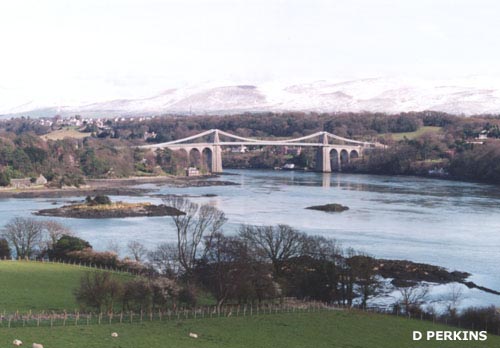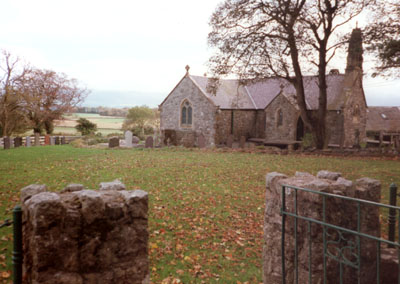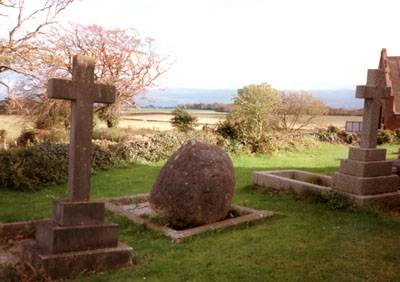
Where is Llansadwrn?

 | Where is Llansadwrn? |
 |

|
Llansadwrn is a village on the island of Anglesey (Ynys Môn) which is off northwest Wales in the UK. Anglesey is separated from the mainland of North Wales, and the county of Gwynedd, by the Menai Strait. It is the most northerly county in Wales. Two bridges connect to the island, one the Menai Suspension Bridge (Pont Borth) built by Thomas Telford and opened in 1826, leads to the town of Menai Bridge (Porthaethwy). The other, the Britannia Bridge (Pont Britannia), originally a tubular railway bridge built by Robert Stephenson and opened in 1850, to Holyhead (Caer Gybi). Since the fire, which almost destroyed it in 1970, it has been rebuilt with arches and two decks. A new roadway, above the railway lines, is now part of the old A5 (London to Holyhead) and the new A55 dual carriage expressway along the coast to Chester and the motorways. The expressway has now been extended from Llanfairpwll to Holyhead.  This bypasses several villages that have seen a tremendous increase in traffic in recent years as a result of heavy traffic to and fro Ireland and introduction of large capacity ferries. The Menai Bridge has also undergone extensive repairs. For some years the road surface had been breaking up, under the weight of modern traffic, and several attempts were made at re-surfacing. Initially these were unsuccessful which has lead to the closure from 18 September 1999 for several months. The engineers (Carillon Laing) completely removed the existing road surface and replaced it, after extensive tests carried out at Imperial College, London. This caused inconvenience to local traffic which use the crossing for daily travel to places of work, shopping and access to the hospital Ysbyty Gwynedd in Bangor. High winds also resulted in the closure or partial closure to high-sided vehicles on several days, using the only other bridge (the Britannia) long delays to and from the island occurred from time to time. The repaired Suspension Bridge reopened to traffic on 23 November 3 weeks ahead of schedule. Unfortunately the repairs to the surface were faulty and further repairs were necessary. Problems with 'bonding' the material used to the deck of the bridge were cited as a possible cause. Warnings of further closure were met with disbelief by the locals. When the suspension bridge was the only road bridge to the island traffic numbers and weight of vehicles were less but there was not this problem. I remember seeing surface repairs being done in the 1960's one lane at a time. The method used seemed to involve hand trowelling semi molten material in sections across the bridge. This seemed to last much longer before repairs were required. Unfortunately it is said that many or all records of the bridge have been lost otherwise this method could be looked at again. Further remedial repair work was done in May 2000, but only one lane was closed at a time and much less congestion was caused. This repair seems to have been completely successful and everyone is pleased with the result. Let's hope that the records of the method are not lost this time!
This bypasses several villages that have seen a tremendous increase in traffic in recent years as a result of heavy traffic to and fro Ireland and introduction of large capacity ferries. The Menai Bridge has also undergone extensive repairs. For some years the road surface had been breaking up, under the weight of modern traffic, and several attempts were made at re-surfacing. Initially these were unsuccessful which has lead to the closure from 18 September 1999 for several months. The engineers (Carillon Laing) completely removed the existing road surface and replaced it, after extensive tests carried out at Imperial College, London. This caused inconvenience to local traffic which use the crossing for daily travel to places of work, shopping and access to the hospital Ysbyty Gwynedd in Bangor. High winds also resulted in the closure or partial closure to high-sided vehicles on several days, using the only other bridge (the Britannia) long delays to and from the island occurred from time to time. The repaired Suspension Bridge reopened to traffic on 23 November 3 weeks ahead of schedule. Unfortunately the repairs to the surface were faulty and further repairs were necessary. Problems with 'bonding' the material used to the deck of the bridge were cited as a possible cause. Warnings of further closure were met with disbelief by the locals. When the suspension bridge was the only road bridge to the island traffic numbers and weight of vehicles were less but there was not this problem. I remember seeing surface repairs being done in the 1960's one lane at a time. The method used seemed to involve hand trowelling semi molten material in sections across the bridge. This seemed to last much longer before repairs were required. Unfortunately it is said that many or all records of the bridge have been lost otherwise this method could be looked at again. Further remedial repair work was done in May 2000, but only one lane was closed at a time and much less congestion was caused. This repair seems to have been completely successful and everyone is pleased with the result. Let's hope that the records of the method are not lost this time!

Llansadwrn is not far from Menai Bridge being more inland and situated about halfway between Pentraeth and Beaumaris. The weather station is not far from the church from which Llansadwrn is named. Llansadwrn (church llan of saint Sadwrn sadwrn) has one of the oldest stone memorials in Wales. It is inscribed to Saturnius and his saintly wife and is believed to date from AD 530. Saturnius is believed to be Sadwrn Farchog, the founder of the church. The church has undergone several restorations. Of interest to geologists is the grave of Sir Andrew Crombie Ramsey (1814-91). He was President of the Royal Geological Society and did pioneering work on the geology of North Wales. He also did work on understanding the effect of glacial erosion on the landscape publishing his work on Old Glaciers of Switzerland and North Wales in 1860. Sir Andrew's grave, in the churchyard, is marked appropriately by a glacial erratic boulder.
These pages are designed and written by Donald Perkins © 1998 - 2014Page dated 3 June 2000llansadwrn-wx.co.uk |